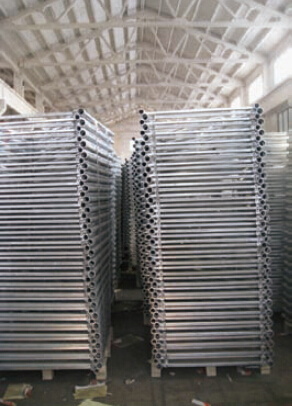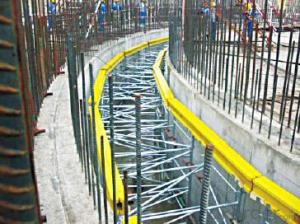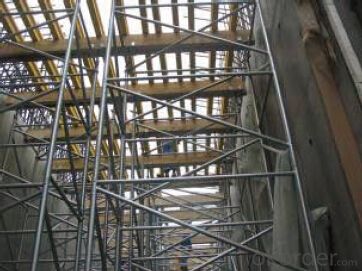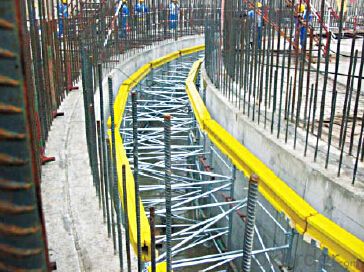Tower Scaffolding for Formwork and Scaffolding Systems
- Loading Port:
- Tianjin
- Payment Terms:
- TT OR LC
- Min Order Qty:
- 50 m²
- Supply Capability:
- 1000 m²/month
OKorder Service Pledge
Quality Product, Order Online Tracking, Timely Delivery
OKorder Financial Service
Credit Rating, Credit Services, Credit Purchasing
You Might Also Like
Tower Scaffolding
Shoring tower is an effective supporting system. It is easy to assemble and dismantlement, and
has excellent stability and bearing capacity. It has been widely used in the construction of industry
& residential buildings , bridges, tunnels and dam project, etc.
Characteristics:
◆ High degree of standardization.
◆ Easy storage and transportation

- Q: What are the different sizes available for steel formwork panels?
- Steel formwork panels are available in various sizes to accommodate different construction needs. The sizes typically range from 1.2 meters to 2.4 meters in width and 1.0 meter to 3.0 meters in height. These dimensions are commonly used in the industry, but manufacturers can also customize the sizes to meet specific project requirements. The selection of the appropriate size depends on factors such as the size of the structure being built, the desired concrete finish, and the ease of transportation and installation. It is important to consult with a professional or supplier to determine the most suitable size for a particular construction project.
- Q: What are the different types of formwork release oils used with steel formwork?
- There are several types of formwork release oils that are commonly used with steel formwork. These oils are used to prevent the concrete from sticking to the steel formwork, making it easier to remove after the concrete has set. Some of the different types of formwork release oils used with steel formwork include: 1. Petroleum-based release oils: These release oils are derived from petroleum and are commonly used in construction projects. They provide a good barrier between the concrete and the steel formwork, preventing adhesion and allowing for easy removal. 2. Vegetable-based release oils: Some formwork release oils are made from vegetable oils, such as soybean or canola oil. These oils are considered to be more environmentally friendly compared to petroleum-based oils. 3. Water-based release agents: Water-based release agents are a popular choice as they are non-toxic and do not emit harmful fumes. They are easy to apply and provide a good release effect on steel formwork. 4. Silicone-based release agents: Silicone-based release agents are known for their excellent release properties. They form a thin layer on the steel formwork, preventing adhesion and ensuring easy removal of the concrete. Silicone-based release agents also provide a high-quality finish to the concrete surface. 5. Polymer-based release agents: Polymer-based release agents are commonly used when a high-quality finish is required on the concrete surface. These agents create a thin film on the steel formwork, preventing adhesion and allowing for easy stripping. It is important to select the appropriate formwork release oil based on the specific requirements of the project, including factors such as the type of concrete being used, environmental considerations, and desired finish of the concrete surface. Consulting with a professional or manufacturer's guidelines is recommended to ensure the correct type of release oil is chosen.
- Q: How does steel formwork affect the overall energy efficiency of a structure?
- Steel formwork can have a significant impact on the overall energy efficiency of a structure. Firstly, steel formwork is known for its durability and strength, which allows it to be reused multiple times. This reusability reduces the need for new formwork materials, thereby minimizing waste generation and conserving resources. By reducing the amount of waste produced during construction, the overall environmental impact is reduced, leading to improved energy efficiency. Additionally, steel formwork offers excellent thermal properties. It has a high thermal mass, meaning it can absorb and store heat energy effectively. This characteristic helps regulate the temperature inside the structure, reducing the reliance on heating or cooling systems. By stabilizing the internal temperature, the energy consumption for climate control is reduced, resulting in improved energy efficiency and lower operational costs. Furthermore, steel formwork enables the construction of energy-efficient designs. Its versatility allows for complex shapes and configurations, facilitating the integration of energy-saving elements such as insulation, ventilation systems, and renewable energy technologies. These features contribute to the overall energy performance of the structure, enhancing its efficiency and sustainability. Overall, steel formwork positively impacts the energy efficiency of a structure by reducing waste, providing excellent thermal properties, and enabling energy-efficient designs. By utilizing steel formwork, construction projects can achieve higher levels of sustainability and contribute to a greener and more energy-efficient built environment.
- Q: Are there any specific considerations for using steel formwork in areas with high seismic activity?
- Yes, there are several specific considerations for using steel formwork in areas with high seismic activity. Firstly, steel formwork is known for its strength and durability, which makes it suitable for withstanding seismic forces. However, in high seismic areas, it is crucial to ensure that the steel formwork is properly designed and constructed to withstand the expected level of seismic activity. This may involve using thicker steel plates or additional reinforcement to enhance the formwork's resistance to seismic forces. Secondly, it is important to consider the connections and joints between different sections of steel formwork. In areas with high seismic activity, these connections should be designed and constructed to be flexible and able to absorb and dissipate seismic energy. This can be achieved through the use of specialized connectors, such as seismic expansion joints or flexible fasteners, which allow for controlled movement during an earthquake. Additionally, proper bracing and anchoring of the steel formwork is essential in high seismic areas. Bracing systems should be designed to provide stability and prevent the formwork from collapsing or tipping over during an earthquake. Anchoring the formwork to the ground or other structural elements can further enhance its stability and resistance to seismic forces. Moreover, it is important to consider the weight and mass of the steel formwork in seismic design. The weight of the formwork can affect the overall stability of the structure during an earthquake. Therefore, it is crucial to ensure that the weight of the formwork is properly accounted for in the seismic design calculations. Lastly, regular inspections and maintenance of the steel formwork are necessary to ensure its continued effectiveness and safety in high seismic areas. Inspections should be conducted to identify any potential damage or deterioration that may have occurred due to seismic activity. Any repairs or reinforcements should be promptly carried out to maintain the integrity and performance of the formwork system. In summary, when using steel formwork in areas with high seismic activity, specific considerations such as proper design, flexible connections, bracing and anchoring, weight calculation, and regular inspections should be taken into account to ensure the safety and effectiveness of the formwork system.
- Q: PVC building template introduction
- VC building templatesPVC building template is also called wood plastic formwork, plastic formwork, plastic formwork. PVC building template is an energy-saving and environment-friendly products, after the wooden template, composite steel formwork, bamboo plywood, all steel template and a new type of product.
- Q: Can steel formwork be used for both simple and complex architectural designs?
- Yes, steel formwork can be used for both simple and complex architectural designs. Steel formwork offers excellent strength and durability, allowing it to handle complex shapes and intricate details with ease. It can be easily assembled and disassembled, making it suitable for various design requirements. Additionally, steel formwork provides a smooth and uniform finish, ensuring high-quality results for both simple and complex architectural designs.
- Q: Are there any health concerns associated with steel formwork?
- Yes, there are potential health concerns associated with steel formwork. These concerns mainly revolve around the use of hazardous chemicals such as paints, coatings, or sealants that may contain volatile organic compounds (VOCs). Prolonged exposure to these VOCs can lead to respiratory issues and other health problems. Additionally, the handling of heavy steel formwork components can pose risks of musculoskeletal injuries if proper safety measures are not followed. It is important to ensure proper ventilation, use protective gear, and follow safety guidelines to mitigate these health concerns.
- Q: How is steel formwork manufactured?
- Steel formwork is manufactured by cutting and shaping steel plates and bars according to the required dimensions and designs. These steel components are then welded together to form the desired formwork panels, beams, and columns. The steel formwork is further reinforced with additional steel bars and mesh, and the surfaces are treated to resist corrosion. Finally, the formwork is assembled and prepared for use in construction projects.
- Q: How does steel formwork handle form release agents?
- Steel formwork handles form release agents differently compared to other types of formwork, such as wood or plastic. Steel formwork typically has smooth and non-porous surfaces, which makes it easier for form release agents to be applied and spread evenly. Form release agents are substances applied to the surfaces of the formwork before pouring concrete. Their main purpose is to prevent the concrete from sticking to the formwork, facilitating easy removal of the formwork after the concrete has set. Steel formwork provides an excellent surface for form release agents to be applied. The smooth and non-absorbent nature of steel allows the release agent to form a thin film or coating on the surface, ensuring a clean separation between the concrete and the formwork. When applying form release agents on steel formwork, it is important to follow the manufacturer's instructions to ensure proper application. Typically, a sprayer or brush is used to evenly distribute the release agent onto the steel surface. It is crucial to apply an adequate amount of release agent to ensure complete coverage, as insufficient application may result in concrete sticking to the formwork. Steel formwork also has the advantage of being reusable, which means that form release agents need to be reapplied for each use. After the concrete has set, the formwork can be easily removed, and any residual form release agent can be cleaned off the steel surface. This allows the formwork to be used multiple times, reducing costs and increasing efficiency in construction projects. In summary, steel formwork handles form release agents effectively due to its smooth and non-porous surface. The even application of form release agents on steel formwork ensures a clean separation between the concrete and the formwork, facilitating easy removal after the concrete has set. The reusability of steel formwork also allows for multiple applications of form release agents, reducing costs and increasing efficiency in construction projects.
- Q: How does steel formwork affect the overall aesthetics of a construction project?
- Steel formwork can have a significant impact on the overall aesthetics of a construction project. Unlike traditional timber formwork, steel formwork offers a sleek and modern appearance that can enhance the visual appeal of a structure. The clean lines and smooth surfaces created by steel formwork can give a building a more polished and sophisticated look. Additionally, steel formwork allows for greater precision and accuracy in shaping concrete, resulting in a more uniform and seamless finish. This can be particularly important in architectural designs that require intricate or complex shapes. The use of steel formwork ensures that the concrete is poured exactly as intended, leading to a more visually appealing end result. Furthermore, steel formwork is highly durable and resistant to wear and tear. Unlike timber formwork, it does not warp or deform over time, maintaining its structural integrity and aesthetic appeal for a longer period. This durability can contribute to the longevity and overall quality of a construction project, making it a more attractive investment for both owners and potential buyers. Another advantage of steel formwork is its adaptability. Steel can be easily molded and shaped into various sizes and configurations, allowing for greater design flexibility. This versatility enables architects and designers to create unique and eye-catching structures that can stand out from the crowd. In summary, the use of steel formwork in a construction project can have a positive impact on its overall aesthetics. Its sleek appearance, precise shaping capabilities, durability, and design flexibility all contribute to a visually appealing end result. Steel formwork can enhance the architectural design, create a more polished finish, and increase the longevity and value of the structure.
Send your message to us
Tower Scaffolding for Formwork and Scaffolding Systems
- Loading Port:
- Tianjin
- Payment Terms:
- TT OR LC
- Min Order Qty:
- 50 m²
- Supply Capability:
- 1000 m²/month
OKorder Service Pledge
Quality Product, Order Online Tracking, Timely Delivery
OKorder Financial Service
Credit Rating, Credit Services, Credit Purchasing
Similar products
Hot products
Hot Searches
Related keywords



















